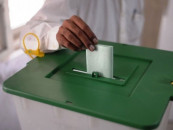Author showcases journey of three faiths through Jerusalem
Dr Iftikhar Salahuddin dedicates visual presentation of award-winning work to Palestine

Dr Iftikhar Salahuddin dedicates visual presentation of award-winning work to Palestine. PHOTO: FILE
Launched in 2013, the author’s work “Jerusalem: A Journey Back in Time”, won the 2014 Karachi Literary Festival Award, as well as the 2014 Peace Prize by the German embassy in Pakistan.
“Most Muslims cannot visit Jerusalem, depriving them of the city’s sanctity,” Salahuddin said, as he began his presentation, which was interspersed with his photography of the city’s historic and holy sites.
These included the Tomb of the Patriarchs, and both its Muslim and Jewish halves; Salahuddin Street; the Church of the Nativity; the Via Dolorosa (The street of sorrow and pain), where Christ was made to carry his cross; Umar Ibn Al-Khattab Square; the Mosque of Omar; Al-Aqsa Mosque; the Western Wall also known as the Wailing Wall; and some of the 112 stained-glass windows of the Dome of the Rock.
Salahuddin said that under Cyrus the Great, Jews were emancipated and invited to return to Jerusalem. “Benjamin Netanyahu today should remember the kindness of the Persians, when he labels them ‘enemies of the Jews’,” he said.
The author also talked about how both the Jews and the Muslims stood together to defend Jerusalem from the Crusaders for 40 days, and how both faiths suffered at the hands of the city’s conquerors.
“All faiths are welcome at the Wailing Wall,” he said, the only remaining legacy of the second temple that was razed by Roman general Titus.
“Men are required to cover their heads at the wall, while women are not,” Salahuddin said, much to the amusement of the audience.
He said he took a bus to enter the city in order to experience the everyday struggle of an average Palestinian. The 20-kilometre ride took over 40 minutes due to constant security checks along the way, Salahuddin said. “A cab must be hired to pass the snaking 40-foot high, 430-km long wall surrounding the city,” he explained.
Dr Salahuddin said that the Palestinians were largely disappointed by the response of the Arab nations to their plight.
German Ambassador Ina Lepel said that Dr Salahuddin’s work was unique for being both an individual travelogue and a historical narration.
Published in The Express Tribune, November 15th, 2015.



















COMMENTS
Comments are moderated and generally will be posted if they are on-topic and not abusive.
For more information, please see our Comments FAQ